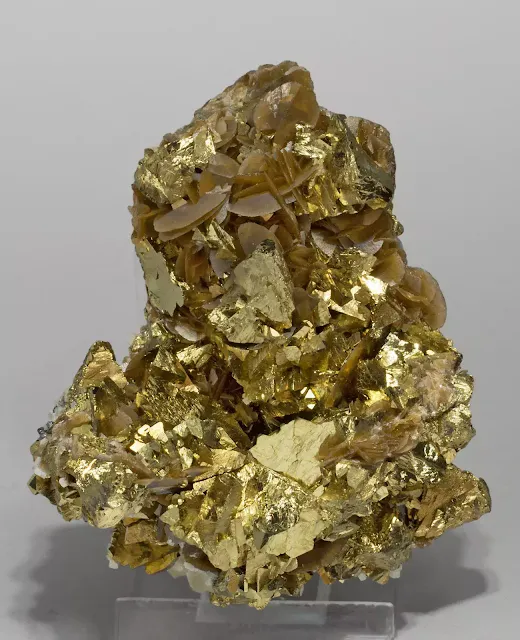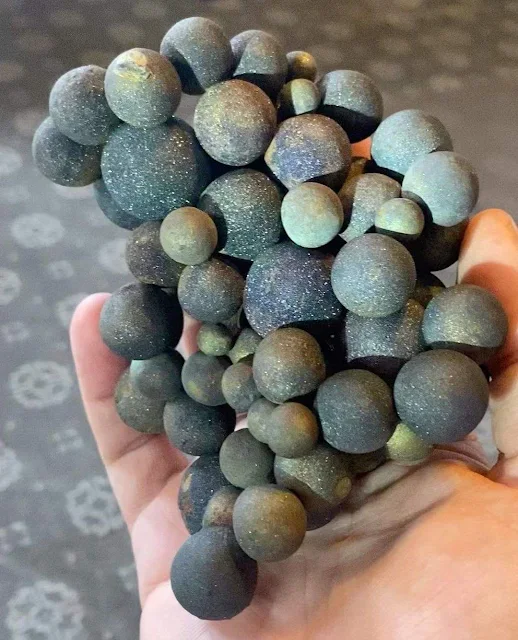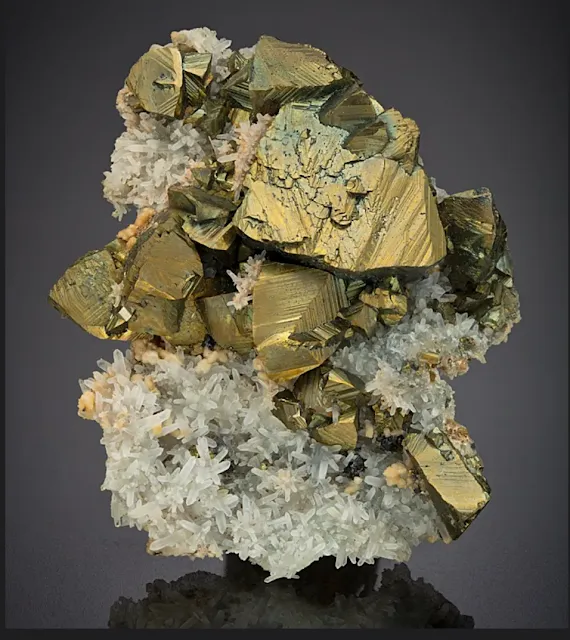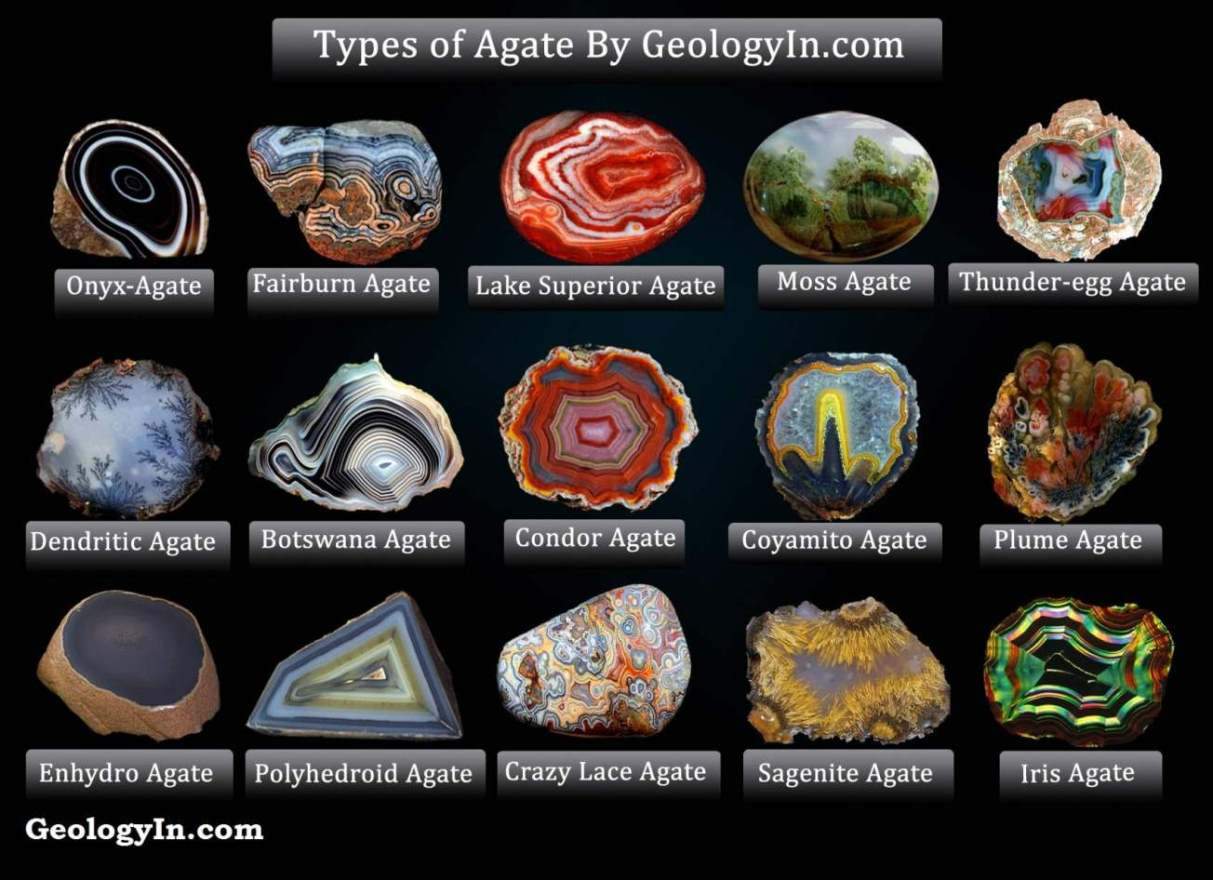Chalcopyrite: Copper Ore, Properties (Photo)
Chalcopyrite is a copper iron sulfide mineral, with the chemical formula CuFeS₂. Because of its abundance and ease of extraction, chalcopyrite is the dominant ore for obtaining copper. It's found in hydrothermal veins and can be associated with other sulfide minerals such as pyrite, sphalerite, and galena. It is also found in igneous rocks and metamorphic rocks.
 |
| Chalcopyrite crystals golden and iridescent, both from Sweetwater Mine, Reynolds County, Missouri, USA |
Chalcopyrite exhibits a brilliant brassy yellow color with a metallic luster. However, weathering processes cause the surface to lose this luster and the color to fade, resulting in a dull, gray-green appearance. Interestingly, exposure to acidic environments can induce the formation of an iridescent tarnish layer, displaying a spectrum of blue and purple hues.
For more than 5,000 years, chalcopyrite has been the primary source of copper sulfide, a key ingredient in the production of copper metal. Chalcopyrite played a vital role in the development of human civilization. From the tools and weapons of the Bronze Age to the electrical wiring and essential components of modern technology, copper extracted from chalcopyrite has been instrumental in shaping our world.
Like pyrite (the more common "fool's gold"), chalcopyrite can also be mistaken for gold due to its brassy yellow color. However, unlike pyrite which has a bright, almost gaudy gold sheen, chalcopyrite has a more subdued, brassy tone with a greenish tinge.
The name "chalcopyrite" comes from the Greek words "chalkos" (copper) and "pyrites" (firestone). So, the name "chalcopyrite" essentially means "copper firestone," reflecting its copper content and the sparking property it possesses. Johann Friedrich Henckel, a German mineralogist, is credited with naming chalcopyrite around 1725. The name aptly captures the essence of this important copper mineral.
 |
| Chalcopyrite with Siderite - Kaiwu Mine, Guizhou Province China |
Properties of Chalcopyrite
Chalcopyrite, the most important copper ore mineral, boasts a unique set of physical, optical, and additional characteristics that aid in its identification and highlight its geological significance.
Composition
Chemical Formula: CuFeS₂(Copper Iron Sulfide). This formula indicates that chalcopyrite is composed of copper, iron, and sulfur atoms in a specific ratio.
Physical Properties
- Color: While fresh chalcopyrite displays a brassy yellow hue, exposure to air can cause it to tarnish. This tarnish often develops an iridescent sheen with shades of blue and purple, making it visually interesting.
- Transparency: Opaque. Chalcopyrite doesn't allow light to pass through.
- Luster: Metallic. This imparts a shiny, almost mirror-like appearance.
- Crystal System: Tetragonal. Crystals exhibit a specific geometric arrangement of atoms at the microscopic level.
- Streak: Greenish-black. This is the color of the powder left behind when scratched against a streak plate, a valuable identification tool for geologists.
- Hardness: 3.5 - 4 on Mohs scale. This indicates that chalcopyrite can be scratched with a knife but not a fingernail.
- Cleavage: Poor/Indistinct. Cleavage refers to how easily a mineral can break along specific planes. Chalcopyrite breaks irregularly.
- Fracture: Irregular/Uneven. The broken surface of chalcopyrite is rough and uneven.
- Habit: Can be massive (lacks a well-defined crystal structure), granular (composed of tiny grains), or form well-defined tetrahedral crystals (pyramid-shaped with four triangular faces).
- Density: 4.1 - 4.3 g/cm³. This refers to the mass per unit volume of chalcopyrite, making it denser than most common rocks.
- Tenacity: Brittle. Chalcopyrite breaks easily and shatters upon impact.
- Solubility: Insoluble in water. However, it can be dissolved by acids like hydrochloric acid or sulfuric acid.
- Magnetism: Not magnetic. Chalcopyrite is not attracted to magnets.
Optical Properties
- Fluorescence: None. Unlike some minerals that emit light under ultraviolet radiation, chalcopyrite doesn't exhibit fluorescence.
- Pleochroism: Not pleochroic. This means the color of chalcopyrite remains the same when viewed from different directions under transmitted light.
- Refractive Index: High (around 1.8 - 1.9). This is a measure of how light bends as it passes through the mineral.
Additional Properties
- Inclusions: Sometimes, chalcopyrite can contain inclusions of other minerals like pyrite (fool's gold) or sphalerite (zinc ore). These inclusions can affect the overall appearance and properties of the chalcopyrite sample.
- Field Indicators: The combination of brassy yellow color, metallic luster, and diagnostic greenish-black streak help geologists readily identify chalcopyrite in the field.
- Associated Minerals: Chalcopyrite is often found alongside other sulfide minerals like pyrite, sphalerite, galena (lead sulfide), and bornite (copper iron sulfide with a different chemical formula). This association helps geologists understand the formation environment of these minerals.
 |
| Natural Botroidal Chalcopyrite Balls crystals from Tonglushan, Daye, China. |
Chalcopyrite Primary Use: Copper Ore
Chalcopyrite is primarily mined for its copper content, which makes it a vital source of copper for various industries.
Dominant Source: Due to its abundance and relative ease of extraction compared to other copper-containing minerals, chalcopyrite reigns supreme as the primary copper ore.
Extraction Methods: Modern copper extraction from chalcopyrite ores utilizes two main methods: pyrometallurgy and hydrometallurgy.
- Pyrometallurgy: This high-temperature process involves crushing, grinding, and flotation to concentrate the chalcopyrite. The concentrate is then smelted to convert it into a copper matte (a mixture of copper and sulfur). Finally, refining processes remove impurities, resulting in pure copper.
- Hydrometallurgy: This method involves dissolving the chalcopyrite concentrate in a solution using various techniques like pressure oxidation leaching. The dissolved copper is then recovered through processes like electrowinning, where electricity is used to plate pure copper onto a cathode.
Copper is widely used in construction for plumbing, roofing, electrical wiring, and heating systems due to its excellent conductivity, durability, and resistance to corrosion. Chalcopyrite-derived copper is a key component in electronic devices such as computers, smartphones, televisions, and appliances. It is used in printed circuit boards, wiring, connectors, and other electronic components.
 |
| Botroidal mass of chalcopyrite var Blister Copper: botryoidal variety of chalcopyrite. Cooks Kitchen Mine, Pool, Carn Brea, Cornwall, United Kingdom |
Occurrence: Where is Chalcopyrite found?
Chalcopyrite is a widely distributed mineral found around the world due to its formation in various geological settings. Here are some of the key places where chalcopyrite is found:
- Hydrothermal Veins: These are mineral deposits formed by hot, mineral-rich fluids circulating through cracks and fractures in rocks. Chalcopyrite is a common mineral found in these veins, often associated with other sulfide minerals like pyrite and sphalerite.
- Massive Sulfide Deposits (MSD): These are large ore bodies composed primarily of sulfide minerals, including chalcopyrite. They are formed by the underwater deposition of mineral-rich fluids along seafloor vents. The Chuquicamata deposit in Chile, one of the world's biggest copper mines, is an example of a massive sulfide deposit rich in chalcopyrite.
- Porphyry Copper Deposits: These are large, low-grade copper deposits found around intrusive igneous rocks (like granite). Chalcopyrite is disseminated (scattered) throughout the rock in small grains. While the copper content is lower than in other deposit types, the vast size of these deposits makes them economically important for copper extraction.
Specific regions known for significant chalcopyrite deposits:
Around the Pacific Rim: This includes countries like Chile, Peru, the Philippines, Papua New Guinea, and Australia.
The Americas: Major deposits are found in North and South America, including the United States, Canada, Mexico, and Bolivia. The Bingham Canyon Mine in Utah, another giant open-pit mine, exploits a porphyry copper deposit with significant chalcopyrite content.
Europe: While not as abundant as in other regions, chalcopyrite deposits exist in countries like Slovakia, the Czech Republic, Germany, and Poland.
Other Regions: Deposits are also found in South Africa, Japan, and other parts of the world.
Remember, the presence of chalcopyrite doesn't guarantee a commercially viable copper mine. The concentration of the mineral and the ease of extraction are crucial factors for economic feasibility.
Chalcopyrite FAQ
Is Chalcopyrite toxic?
Chalcopyrite itself is not toxic, but like many sulfide minerals, it can produce sulfuric acid when exposed to air and water. This acid can be harmful to the environment if not properly managed during mining and processing operations.
Does all chalcopyrite have iridescent colors?
No, not all chalcopyrite exhibits iridescence. In its fresh state, it typically has a brassy or golden yellow color.
What causes the iridescence in chalcopyrite?
Chalcopyrite itself isn't iridescent, but it can tarnish over time to develop beautiful iridescent colors. This tarnishing process involves a thin film of oxides forming on the surface of the mineral, which causes light to interfere and diffract, creating a rainbow-like effect. The most common iridescent colors seen in tarnished chalcopyrite are purples, blues, and reds. These colors can be quite intense and form concentric, irregular rings on the surface . It's important to note that this iridescence is not a natural property of chalcopyrite, but rather a result of weathering and oxidation.
 |
| Chalcopyrite Streak: Greenish black |
Chalcopyrite stands as the cornerstone of global copper production. Its abundance, combined with its high copper content, makes it the most crucial copper ore mineral. The continued development of sustainable and environmentally friendly extraction techniques will be essential for the responsible utilization of chalcopyrite as a source of this vital metal.
Read also:
Pyrite: Properties, Uses, Occurrence, Toxicity
Hematite: Properties, Uses, Meaning
Peacock Rocks




%20(1).webp)





